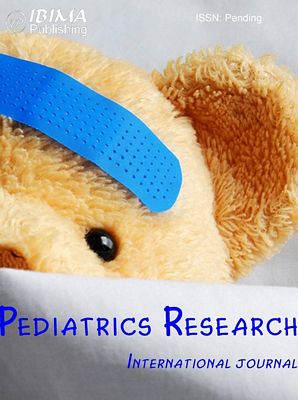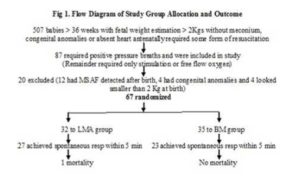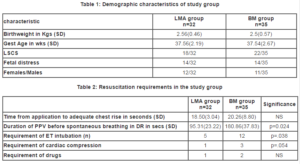Introduction
The Laryngeal Mask Airway (LMA) is a simple device with which positive pressure ventilation can be given during resuscitation. Though it can be used as a primary mode of ventilation in resuscitation, it is recommended to be used as an alternate airway when you ‘can’t ventilate and can’t intubate’ in neonatal resuscitation (2011). Self inflating or flow inflating bags with masks and recently T-piece resuscitators are still recommended as the initial mode of giving positive pressure ventilation. This study was undertaken to determine if LMA was as effective as Bag and Mask (BM) as a primary mode of giving positive pressure ventilation in neonatal resuscitation.
Methodology
The study was conducted in a tertiary care teaching hospital with a delivery rate of 3000/year and approximately 10% of neonates requiring some form of assistance at birth. From hospital records, it was seen that the average duration of positive pressure ventilation (PPV) with BM before onset of spontaneous respiration in the Delivery Room (DR) was 177 + 62 seconds. To determine a 25% decrease in PPV in the LMA group with a power of 80% and alpha error of 0.05, it was calculated that a sample size of 61 would be required. An additional 10% was taken. Clearance of Ethics Committee of the Institute was taken for the conduct of the study. Informed consent of the either parent was taken before delivery. Pregnancies >36 weeks with estimated fetal weight >2000 grams who required positive pressure ventilation at birth were included in the study. Those with Meconium Stained Amniotic Fluid (MSAF), antenatally detected congenital anomalies or with no heart beat detected before delivery were excluded. At delivery birth babies stained with meconium, ‘looking smaller than 2 Kg’ or those with obvious anomalies not detected antenatally were also excluded. Allocation to groups was done by assigning babies born on odd days to the LMA group and those born on even days to the BM group.
Resuscitation protocol followed was that of the American Heart Association. Adequacy of breaths was assessed by chest rise and audible breath sounds bilaterally. Response to ventilation was assessed by an increase in heart rate. Babies were intubated with endotracheal tube if there was no increase in heart rate within 30-45 seconds of PPV despite adequate chest rise, if need for PPV exceeded 5 minutes or if cardiac compressions were indicated.
Resuscitation was done by 6 trained doctors in their 2nd and 3rd years of Pediatric residency, over a period of 2 years. All the resuscitators were initially trained on infant manikins, and then supervised by a Neonatologist for the first month during actual resuscitation. It was ensured that they were proficient in delivering positive pressure breaths with both the BM and LMA as well as in intubation and giving CPR/ drugs. Equipment used included self-inflating bag with appropriate sized masks (Laedral) and No 1 size disposable LMA manufactured by Laryngeal Mask Company and marketed by Anesthetics, India. After insertion of LMA, filling of cuff was done by pushing 2-4 ml of air which was kept ready in a syringe. Time to adequate chest rise was calculated as the time from the beginning of application of device to visual evidence of chest rise with ventilation. Duration of PPV was calculated from onset of PPV till onset of spontaneous respirations. Both timings were recorded by an assistant with a second’s timer. The number of babies requiring cardiac compression, drugs and intubation were noted. The presence of gastric dilatation or trauma during use of either device was also recorded. All babies requiring PPV for > 2 minutes had an orogastric (BM group) or nasogastric (LMA group) inserted to act as a vent. The duration of hospital stay and mortality data were retrieved from NICU data.
Mann Whitney test and Fischer’s exact test were used to compare the two groups.
Results
Flow diagram of study group and allocations is given in Figure 1. Of 87 babies requiring PPV in the DR, 32 babies were systematically allotted to the LMA group, while 35 were allotted to the BM group.
The demographic characteristics of the study population in the two groups did not differ in birth weight or gestational age, sex or prior fetal distress. Though there were more babies born by Caesarean section in the BM group, this did not achieve statistical significance (Table 1).
When the two groups were compared in the outcome measures, it was found that the time to chest rise was the same in the two groups, [18.50(3.04) in LMA group and 20.26(8.80) in the BM group]. However, the time required to give PPV before onset of spontaneous respiration in the DR was significantly lower in the LMA group [(95.31(23.22) in LMA group vs. 180(37.83) in BM group]. The need for endotracheal intubation was also significantly lower in the LMA group (5 as compared with 12). In the requirement of drugs and cardiac compression, both groups were the same (Table 2).
No significant gastric dilatation or oral trauma was noted in any baby of either group. On the follow up of the two groups, the length of hospital stay in days [(5.12(2.4) vs 6.21(4.1)] and mortality (Fig 1) was not different in the two groups.
Discussion
Since it was first introduced into patient care, the LMA has been gaining increasing popularity for resuscitation of all age groups. Denny (1990) first reported using the LMA to resuscitate a term neonate for emergency tracheostomy. The LMA has been included in the American Heart Association Textbook of Neonatal Resuscitation (Kattwinkel, 2011) since 2000 as an alternate airway, and its usefulness has been stressed in the 2010 guidelines as a rescue airway method of giving positive pressure breaths. Patterson (1994) first used it effectively as a primary mode of ventilation in 20 term neonates. However, the LMA seems to be more popular with Anaesthesiologists than Pediatricians. In a study done in Italy by Trevisanuto and co-workers (2004), the LMA was considered to be an essential device more frequently by the Anaesthesiologists than by the Paediatricians (27% versus 5%).
The LMA is known to require less skill in application and is easier to maintain as compared to BM. Training to use an LMA on an infant intubation manikin is very easy and effective. In an Australian study by Gandini and Brimacombe (2004) on brief training, it was found that the time to insertion was 5+2 sec and there were no failed insertions. On questioning the participants, before and after training, the preferred technique for neonatal resuscitation changed from 72 to 14% for BM and from 6 to 80% for the LMA. The same authors, however, had 10 years ago cautioned that more studies should be done before LMA can be recommended universally as a primary mode of resuscitation in neonates (1995). Though there is a fear that the LMA may cause injury or obstruction if not placed properly, this has not been reported. Trevisanuto et al (2004) analyzed the incidence of endotracheal intubation before and after the use of LMA in neonatal resuscitation. Over this period, the percentage of neonates receiving tracheal intubation at birth (34%) was significantly reduced compared with earlier figures (67%). In a recent study on training in use of LMA in a resource-limited country Zanardo (2010), it has been shown that both physicians and paramedics showed a significant improvement in their knowledge post training.
In our study, we found that more babies achieved spontaneous respiration in the DR within the first 5 minutes in a shorter time and lesser needed intubation in the LMA group, as compared to babies resuscitated with bag and mask. This suggests that the LMA was a more effective way of giving PPV in the DR. The long-term outcome, however, did not appear to be different in the two groups. There were no complications noted with the use of the LMA.
The drawback of the study was that babies were systematically allotted to the two groups and that lack of randomization may have resulted in bias. This method of allocation was done so that no time was wasted in opening random number envelopes just before the resuscitation. Also, the numbers in our study were small. There is some evidence that the LMA may be as if not more effective as BM in neonatal ventilation. However, due to lack of large, multicentric RCTs, the evidence to recommend LMA in lieu of bag and mask as a primary mode of ventilation may still not be possible.
References
1. Brimacombe J, Gandini D (1995). “Resuscitation of Neonates with the Laryngeal Mask Airway- A Caution” (letter). Pediatrics ; 95(3):453
2. Denny NM, Desilva KD, Webber PA (1990). “Laryngeal Mask Airway for emergency tracheostomy in a neonate” (letter). Anesthesia; 45 (2):895.
Publisher – Google Scholar
3. Gandini D, Brimacombe J (2004). “Manikin training for neonatal resuscitation with the Laryngeal Mask Airway”. Paediatr Anaesth; 14(6): 493-494.
Publisher – Google Scholar
4. Kattwinkel J (ed). “AHA Textbook of Neonatal Resuscitation (2011). Endotracheal Intubation and Laryngeal Mask Airway Insertion”. 6th Edition (Indian). Jaypee Brothers Medical Publishers (P) Ltd : 159-210.
5. Paterson SJ, Byrne PJ, Molesky MG (1994). “Neonatal resuscitation using the Laryngeal Mask Airway”. Anesthesiology; 80(6): 1248-1253.
Publisher – Google Scholar
6. Trevisanuto D, Ferrarese P, Zanardo V (2004). “Laryngeal Mask Airway in neonatal resuscitation: a survey of current practice and perceived role by anaesthesiologists and paediatricians”. Resuscitation. 2004; 60(3):291-296.
Publisher – Google Scholar
7. Trevisanuto D, Micaglio M, Pitton (2004). Laryngeal mask airway: is the management of neonates requiring positive pressure ventilation at birth changing? Resuscitation; 62(5):151-157.
Publisher – Google Scholar
8. Zanardo V, Simbi A, Micaglio M (2010). “Laryngeal Mask Airway for neonatal resuscitation in a developing country: evaluation of an educational intervention”. BMC Health Services Research , 10:254-259.
Publisher – Google Scholar





